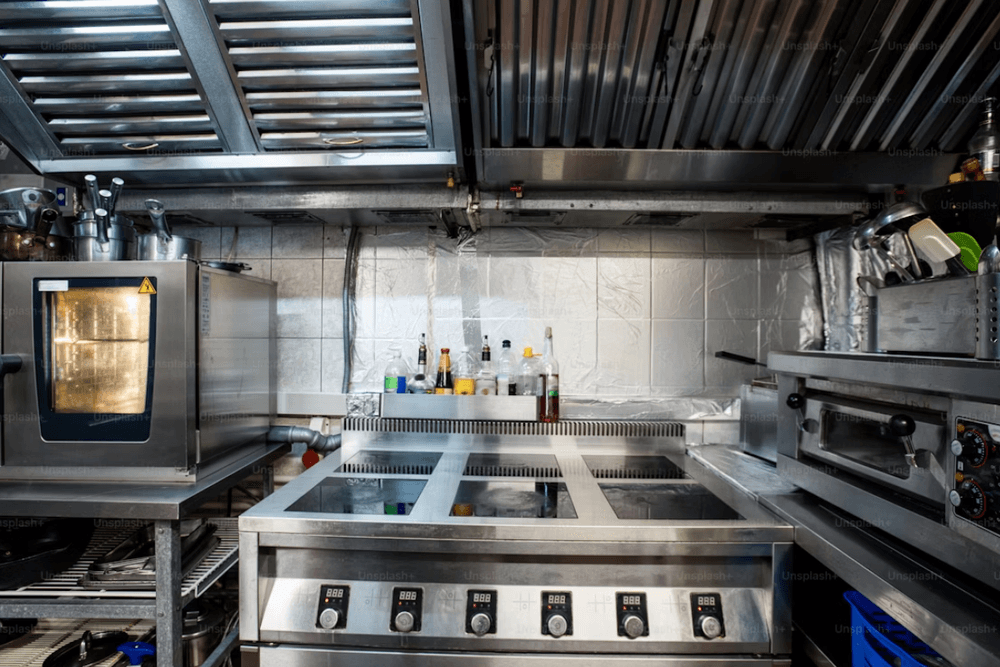Shared Commissary Kitchens vs. Ghost Kitchens: Which Model Fits Your Food Business Needs?
Table of Contents
CloudKitchens
How many tacos can be delivered from a 1000sqft restaurant?
The same amount as a 200sqft ghost kitchen.
Compare the benefits and challenges of shared commissary kitchens and ghost kitchens to find the best fit for your food business.
Choosing the type of kitchen is a decision that can directly impact your operations and growth. While shared commissary kitchens can support alternative uses and flexible business models, ghost kitchens are primarily focused on delivery, serving brands that prioritize efficiency and scalability in the online market.
In 2023, the global market for ghost kitchens reached a value of US$ 56.71 billion and is expected to more than double by 2032, hitting US$ 115.21 billion, with an average annual growth rate of 11.42%.
In this guide, you will learn what differentiates shared kitchens from ghost kitchens in terms of structure, operation, and viability. This reading will help you identify which format best aligns with your business goals and your current operational stage in the food business landscape.
Read more: Shared Vs. Private Kitchens: Making the right choice for your business
What’s the Difference Between Shared Commissary Kitchens and Ghost Kitchens
Shared commissary kitchens and ghost kitchens are two modern models of food production spaces, but they have important differences in structure, operation, and business focus.
Shared commissary kitchens are commercial kitchens where multiple entrepreneurs and brands share the same physical kitchen. Each user rents a space or time slot to prepare their food, using shared equipment and infrastructure. This model is ideal for:
- Small chefs and bakers who do not have their own kitchen.
- Food trucks that need space for preparation and storage.
- Entrepreneurs testing new products with low initial investment.
Ghost kitchens, on the other hand, are commercial kitchens dedicated to preparing orders without in-person customer service. They are operated by one or more brands that function primarily in the digital environment, focused on delivery, bulk, or meal prep operations.
Key Differences:
- Purpose: Shared commissary kitchens provide infrastructure access to various small businesses; ghost kitchens are designed to maximize efficiency for virtual brands, meal prep, and bulk operations.
- Operation: Shared commissary kitchens host multiple entrepreneurs sharing space and schedules; ghost kitchens can be exclusive to one brand or serve multiple delivery-only brands.
- Revenue Model: Shared commissary kitchens generate revenue by renting space and time; ghost kitchens focus on integrated operations of virtual brands with centralized technology and logistics.
Operational Pros and Cons
When choosing between shared commissary kitchens and ghost kitchens, it is essential to understand how operational differences directly impact daily business activities. Below, we explore the details of each model and how they can affect operations.
Privacy
Shared Commissary Kitchens: Space is shared among multiple users, which reduces privacy during food preparation and may cause interference between teams.
Ghost Kitchens: Space is exclusive or dedicated to a single operation, ensuring greater privacy, security, and control over internal processes.
Flexibility
Shared Commissary Kitchens: Space use depends on availability and scheduling, which limits operational flexibility and can restrict peak-hour activity.
Ghost Kitchens: Operations can run continuously, 24/7, as needed by the business, without reliance on third parties.
Storage
Shared Commissary Kitchens: Storage space is limited and generally shared among several users, which can make stock organization difficult.
Ghost Kitchens: Provide dedicated, personalized storage, allowing better organization and security of ingredients and supplies.
Cleaning
Shared Commissary Kitchens: Cleaning responsibilities are shared among users, which can lead to conflicts over standards and frequency.
Ghost Kitchens: Cleaning is managed internally, following consistent standards and ensuring a suitable environment for food preparation.
Scheduling
Shared Commissary Kitchens: Requires coordinating and reserving time slots in advance, which can cause conflicts and limit space usage.
Ghost Kitchens: Scheduling is exclusive to the operator, eliminating external interference and ensuring full control over routines.
Equipment Availability
Shared Commissary Kitchens: Equipment is shared, which may lead to disputes over use or faster wear due to multiple users.
Ghost Kitchens: Equipment is exclusive or guaranteed for each operation, optimized for delivery models and properly maintained.
Shared Space Means Shared Rules
In shared kitchens, space is divided among several users, requiring rules to keep everyone organized. This environment can be challenging since each business has different needs and schedules.
A major challenge is scheduling conflicts. Because kitchen use is reserved, it can be difficult to secure time slots that meet everyone’s needs, especially during busy periods.
Moreover, workflow can be disrupted by the division of equipment and space. This may cause delays, reduce productivity, and make it harder to handle unexpected demand.
Ghost Kitchens Offer Full Control
Ghost kitchens provide exclusive space for each operation, eliminating common interruptions found in shared kitchens. This exclusivity allows customized organization for greater efficiency.
Without needing to schedule time or share equipment, teams can work continuously and without interruptions, enabling quick responses to demand peaks and improving service.
This total control ensures optimized workflow, greater speed, and consistency in food preparation, key factors for success in delivery.
Cost Comparison
Cost is a key factor when choosing between shared commissary kitchens and ghost kitchens. Each model has different investment and fee structures that impact your budget and financial planning.
Shared Commissary Kitchens
- Initial Investment: Costs can vary widely depending on the case, especially because space and equipment are shared among multiple users, which may reduce expenses but require adaptations.
- Monthly Fees: Usually based on usage, either by hours or rented days, fluctuating with demand and space availability.
- Financial Flexibility: Viable for businesses just starting or operating on a smaller scale, but dependence on shared schedules can limit flexibility.
- Limitations: Shared space means less control over the environment and possible extra costs if usage exceeds the contract or if specific adaptations are needed.
Ghost Kitchens
- Initial Investment: With CloudKitchens, an initial investment is significantly lower than opening a traditional kitchen. This covers basic infrastructure and essential equipment such as hooks, prep tables, sinks, and other systems.
- Monthly Fees: Generally fixed, including exclusive use of the space, complete infrastructure, and operational support. This predictability helps with monthly financial planning.
- Financial Autonomy: The model offers greater budget predictability, with fixed monthly costs allowing tighter expense control and avoiding common financial surprises.
- Benefits: Besides improving operational efficiency, this control over the environment and processes can lead to medium- and long-term savings through resource optimization and waste reduction.
Understanding the food facility cost involved in both models is key to making an informed decision on your kitchen rentals.
What’s Included in the Cost?
In shared commissary kitchens, monthly costs include renting space for scheduled hours, basic equipment maintenance, and common cleaning. These responsibilities are shared among users. Some units offer licensing support and utilities, but services are usually limited.
Dedicated ghost kitchens offer a more comprehensive package, including active support for licenses, preventive maintenance, regular cleaning, and payment of utilities like water, gas, and electricity. This eases operations and reduces administrative concerns.
When evaluating costs, it is important to consider not only the financial value but also the support and convenience offered. These factors impact efficiency and the ability to focus on business growth.
Compliance and Licensing Differences
Operating a commercial kitchen requires meeting all legal and regulatory standards to ensure food safety and business integrity. Both shared commissary kitchens and ghost kitchens must comply with federal, state, and local requirements, such as:
- Licenses and Certifications: Food handlers and supervisors must have specific certifications, including training and exams related to food safety.
- Food Business Licenses: Health inspections verify compliance with hygiene, storage, labeling, and food preparation rules.
- Mechanical and Plumbing Codes: Kitchens must meet technical standards such as the Uniform Mechanical Code for exhaust systems, grease traps, and sanitation.
- Certificate of Occupancy: After property inspections, approval is issued confirming suitability for food operations.
- Fire Department Inspections: Safety checks include emergency exits, sprinkler systems, and alarms.
- Sanitary Evaluations: Analysis of sewage access and waste management.
- Regular Health Inspections: Ongoing checks ensure hygiene maintenance, temperature control, and safety protocols.
- HACCP Plans: Essential to identify risks and implement controls to prevent contamination.
- Workplace Safety: Occupational safety standards must be followed, including accident prevention and emergency signage.
- Recommended Certifications: Equipment certified by NSF, for example, facilitates passing inspections.
- Zoning and Occupancy Compliance: Properties must have municipal authorization for commercial food use.
Licensing a ready-to-use ghost kitchen, like those offered by CloudKitchens, often streamlines this process. These spaces are designed, equipped, and operated within current sanitary and regulatory standards, reducing bureaucracy and compliance risks for entrepreneurs.
Read more: Common health code violations in restaurants and how to fix them
Who Each Kitchen Model Is Best Suited For
Shared commissary kitchens can be a viable option for those starting in the industry or still validating their business model. Despite operational limitations like shared space and scheduling, they offer an accessible entry point with lower short-term costs.
- Beginner cooks looking to test menus without investing in their own kitchen.
- Part-time entrepreneurs working alternative hours and not requiring continuous operation.
- Local businesses focusing on occasional or low-volume production.
Ghost kitchens are well-suited for operations with scaling ambitions, including meal prep, catering, and bulk production. The model provides a dedicated environment with greater predictability, agility, and control, ideal for brands prioritizing efficiency and structured growth.
- Digital-only brands operating exclusively through delivery apps.
- Food service companies seeking quick expansion to new neighborhoods or cities.
- Multi-brand operators wanting to run different concepts simultaneously in one location.
Scaling Potential With Each Model
A business’s ability to scale depends directly on operational flexibility and the capacity to replicate the operation consistently. There are significant differences between each model in this regard.
Shared commissary kitchens offer an affordable structure but with limitations. Space usage depends on scheduling and availability, which may restrict operations during peak times.
Expanding to new regions requires finding new kitchens with similar features and facing bureaucratic processes again. This reduces agility and can increase operational costs.
Ghost kitchens, however, are designed to facilitate expansion. With dedicated spaces and standardized infrastructure, they can operate full-time, test new brands, and quickly adjust to order volume without relying on third parties.
Additionally, opening new units in different regions using an established model reduces startup time and eliminates a large part of installation costs. This makes ghost kitchens a solution for brands focused on growth.
Choose a Kitchen That Supports Your Growth
Choosing the right kitchen model can accelerate or hinder your business evolution. Ghost kitchens are designed to scale efficiently, offering ready infrastructure, full control, and support for those seeking fast growth in the delivery market.
With CloudKitchens, you get private kitchens that are already licensed and ready to operate in strategic locations optimized for delivery and distribution. Avoid worries about scheduling, maintenance, or sanitary compliance and focus on what truly matters: growing your business.
Contact a specialist now and learn about the CloudKitchens units available in your area. Take your brand further with the right infrastructure from the start.
FAQ – Shared Commissary Kitchens vs. Ghost Kitchens
What is the main difference between a shared commissary kitchen and a ghost kitchen?
A shared commissary kitchen is a communal kitchen space for multiple food businesses, while a ghost kitchen focuses solely on delivery without a customer-facing storefront.
Which option is more cost-effective for new food entrepreneurs?
Shared commissary kitchens often have lower startup costs and flexible usage, making them ideal for beginners, whereas ghost kitchens can require more investment but offer scalable delivery-focused operations.
Can I switch between using a shared commissary and a ghost kitchen?
Yes, many food businesses start in a shared commissary kitchen and transition to a ghost kitchen as they grow or shift their business model.
DISCLAIMER: This information is provided for general informational purposes only and the content does not constitute an endorsement. CloudKitchens does not warrant the accuracy or completeness of any information, text, images/graphics, links, or other content contained within the blog content. We recommend that you consult with financial, legal, and business professionals for advice specific to your situation.
More insights & stories
There’s more where that came from.
Get in the know and check out our additional insights





